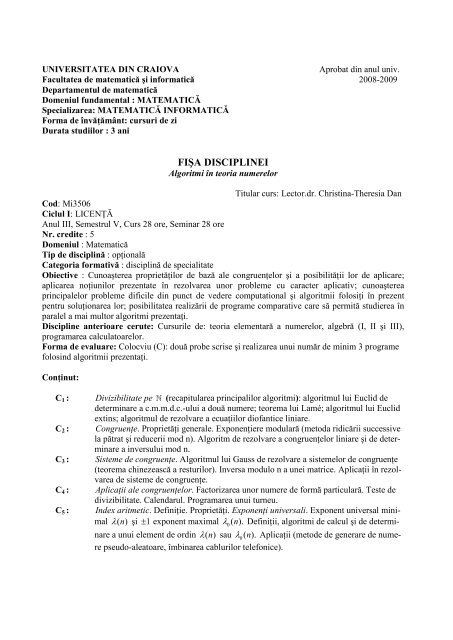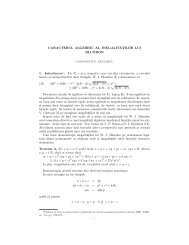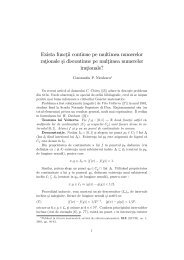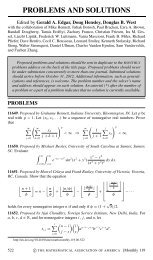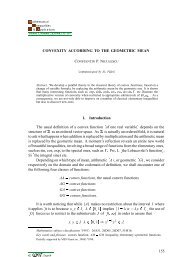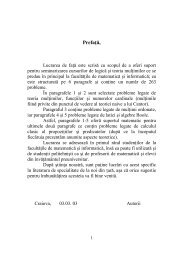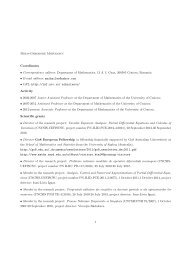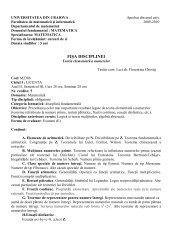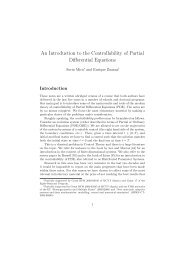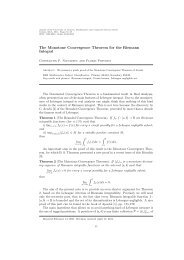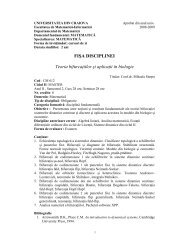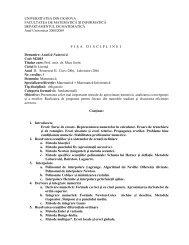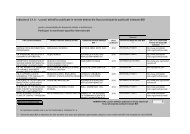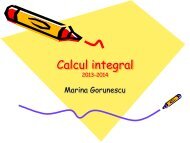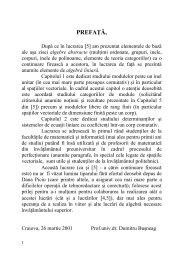Algoritmi in teoria numerelor - Departamentul de Matematică
Algoritmi in teoria numerelor - Departamentul de Matematică
Algoritmi in teoria numerelor - Departamentul de Matematică
Create successful ePaper yourself
Turn your PDF publications into a flip-book with our unique Google optimized e-Paper software.
UNIVERSITATEA DIN CRAIOVA<br />
Aprobat d<strong>in</strong> anul univ.<br />
Facultatea <strong>de</strong> matematică şi <strong>in</strong>formatică 2008-2009<br />
<strong>Departamentul</strong> <strong>de</strong> matematică<br />
Domeniul fundamental : MATEMATICĂ<br />
Specializarea: MATEMATICĂ INFORMATICĂ<br />
Forma <strong>de</strong> învăŃământ: cursuri <strong>de</strong> zi<br />
Durata studiilor : 3 ani<br />
FIŞA DISCIPLINEI<br />
<strong>Algoritmi</strong> în <strong>teoria</strong> <strong>numerelor</strong><br />
Titular curs: Lector.dr. Christ<strong>in</strong>a-Theresia Dan<br />
Cod: Mi3506<br />
Ciclul I: LICENłĂ<br />
Anul III, Semestrul V, Curs 28 ore, Sem<strong>in</strong>ar 28 ore<br />
Nr. credite : 5<br />
Domeniul : <strong>Matematică</strong><br />
Tip <strong>de</strong> discipl<strong>in</strong>ă : opŃională<br />
Categoria formativă : discipl<strong>in</strong>ă <strong>de</strong> specialitate<br />
Obiective : Cunoaşterea proprietăŃilor <strong>de</strong> bază ale congruenŃelor şi a posibilităŃii lor <strong>de</strong> aplicare;<br />
aplicarea noŃiunilor prezentate în rezolvarea unor probleme cu caracter aplicativ; cunoaşterea<br />
pr<strong>in</strong>cipalelor probleme dificile d<strong>in</strong> punct <strong>de</strong> ve<strong>de</strong>re computational şi algoritmii folosiŃi în prezent<br />
pentru soluŃionarea lor; posibilitatea realizării <strong>de</strong> programe comparative care să permită studierea în<br />
paralel a mai multor algoritmi prezentaŃi.<br />
Discipl<strong>in</strong>e anterioare cerute: Cursurile <strong>de</strong>: <strong>teoria</strong> elementară a <strong>numerelor</strong>, algebră (I, II şi III),<br />
programarea calculatoarelor.<br />
Forma <strong>de</strong> evaluare: Colocviu (C): două probe scrise şi realizarea unui număr <strong>de</strong> m<strong>in</strong>im 3 programe<br />
folos<strong>in</strong>d algoritmii prezentaŃi.<br />
ConŃ<strong>in</strong>ut:<br />
C 1 :<br />
C 2 :<br />
C 3 :<br />
C 4 :<br />
C 5 :<br />
Divizibilitate pe N (recapitularea pr<strong>in</strong>cipalilor algoritmi): algoritmul lui Euclid <strong>de</strong><br />
<strong>de</strong>term<strong>in</strong>are a c.m.m.d.c.-ului a două numere; teorema lui Lamé; algoritmul lui Euclid<br />
ext<strong>in</strong>s; algoritmul <strong>de</strong> rezolvare a ecuaŃiilor diofantice l<strong>in</strong>iare.<br />
CongruenŃe. ProprietăŃi generale. ExponenŃiere modulară (metoda ridicării successive<br />
la pătrat şi reducerii mod n). Algoritm <strong>de</strong> rezolvare a congruenŃelor l<strong>in</strong>iare şi <strong>de</strong> <strong>de</strong>term<strong>in</strong>are<br />
a <strong>in</strong>versului mod n.<br />
Sisteme <strong>de</strong> congruenŃe. Algoritmul lui Gauss <strong>de</strong> rezolvare a sistemelor <strong>de</strong> congruenŃe<br />
(teorema ch<strong>in</strong>ezească a resturilor). Inversa modulo n a unei matrice. AplicaŃii în rezolvarea<br />
<strong>de</strong> sisteme <strong>de</strong> congruenŃe.<br />
AplicaŃii ale congruenŃelor. Factorizarea unor numere <strong>de</strong> formă particulară. Teste <strong>de</strong><br />
divizibilitate. Calendarul. Programarea unui turneu.<br />
In<strong>de</strong>x aritmetic. Def<strong>in</strong>iŃie. ProprietăŃi. ExponenŃi universali. Exponent universal m<strong>in</strong>imal<br />
λ ( n)<br />
şi ± 1 exponent maximal λ ( n).<br />
0<br />
Def<strong>in</strong>iŃii, algoritmi <strong>de</strong> calcul şi <strong>de</strong> <strong>de</strong>termi-<br />
nare a unui element <strong>de</strong> ord<strong>in</strong> λ ( n)<br />
sau λ ( n).<br />
0<br />
AplicaŃii (meto<strong>de</strong> <strong>de</strong> generare <strong>de</strong> numere<br />
pseudo-aleatoare, îmb<strong>in</strong>area cablurilor telefonice).
C 6 : Teste <strong>de</strong> primalitate <strong>de</strong>term<strong>in</strong>istice. Căutare <strong>de</strong> divizori primi pr<strong>in</strong> încercări. Teste<br />
n − 1. Test Pep<strong>in</strong>. Teste n + 1. Test Lucas-Lehmer. Algoritmul AKS.<br />
C 7 : Teste <strong>de</strong> primalitate probabilistice. Test Fermat. Algoritm <strong>de</strong> calcul al simbolului<br />
Jacobi. Test Solovay-Strassen. Test Miller-Rab<strong>in</strong>.<br />
C 8 – C 9 : Problema factorizării. GeneralităŃi. Factorizare pr<strong>in</strong> căutare directă . Metoda Fermat.<br />
Metoda Pollard-rho. Metoda Pollard p-1. Metoda bazei factor. Metoda fracŃiilor cont<strong>in</strong>ue.<br />
Metoda filtrului pătratic. Metoda curbelor eliptice. Filtrul corpului <strong>de</strong> numere.<br />
C 10 – C 11 : Problema logaritmului discret (DLP). GeneralităŃi. Algoritmul Shanks (baby-step<br />
giant-step). Algoritmul Silver-Pohlig-Hellman. Algoritmul Pollard-rho. Algoritmul<br />
<strong>in</strong><strong>de</strong>x-calculus (pentru <strong>de</strong>term<strong>in</strong>area log discret în corpuri f<strong>in</strong>ite).<br />
C 12 : Problema rădăc<strong>in</strong>ilor pătrate mod n. Algoritm <strong>de</strong> <strong>de</strong>term<strong>in</strong>are a unei rădăc<strong>in</strong>i pătrate<br />
modulo p, un număr prim. Variante pentru cazurile particulare: p ≡ 3(mod 4),<br />
C 13 – C 14 :<br />
s<br />
p ≡ 5(mod 8) şi p − 1 = 2 t,<br />
cu s număr mare. Rădăc<strong>in</strong>i pătrate modulo n = pq,<br />
cu p<br />
şi q numere prime dist<strong>in</strong>cte. Metodă flip co<strong>in</strong>.<br />
Problema sumei unei submulŃimi (subset-sum problem) şi problema rucsac (knapsack<br />
problem). NoŃiuni <strong>in</strong>troductive. <strong>Algoritmi</strong> pentru rezolvarea computaŃională a problemei.<br />
Algoritm <strong>de</strong> <strong>de</strong>term<strong>in</strong>are a unei baze reduse cunoscând o bază a unei lattice<br />
n<br />
L ⊆ R . Aplicarea algoritmului anterior la rezolvarea problemei subset-sum <strong>de</strong> <strong>de</strong>nsitate<br />
scăzută şi la aproximarea simultană diofantică (metodă folosită în atacuri asupra<br />
criptosistemelor).<br />
Bibliografie:<br />
1. Buşneag, D., Boboc, F., Piciu, D., Aritmetică şi <strong>teoria</strong> <strong>numerelor</strong>, Editura Universitaria,<br />
Craiova, 1999.<br />
2. Dan, C., <strong>Algoritmi</strong> în <strong>teoria</strong> <strong>numerelor</strong>, Editura Universitaria, Craiova, 2005.<br />
3. D<strong>in</strong>că, Al., Introducere în <strong>teoria</strong> algebrică a <strong>numerelor</strong>, Editura Universitaria, Craiova, 2006.<br />
4. Koblitz, N., A Course <strong>in</strong> Number Theory and Cryptography, Spr<strong>in</strong>ger-Verlag, Berl<strong>in</strong>, 1994.<br />
5. Knut, D.E., The Art of Computer Programm<strong>in</strong>g, vol. I, ed. a II-a, Addison-Wesley, 1973.<br />
6. Rosen, K. H., Elementary Number Theory and Cryptography, Addison-Wesley, 1993.


